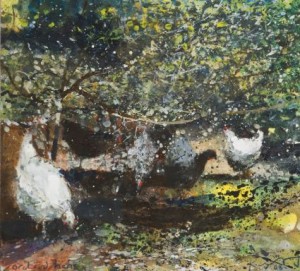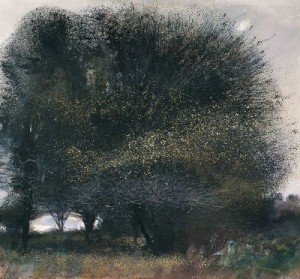Messum’s Gallery, Cork Street, Mayfair, London W1. January 14 – 31, 2009.
I first came across Kurt’s work last Spring, when I picked up a postcard of one of his paintings. It was a copy of an oil painting depicting (if I remember right) the Kennet & Avon Canal. I liked it a lot. I stuck it on the wall in my shed and eventually, out of curiosity, I googled him.
This happened at the same time as Robin, Andrew & I were starting to compile our wish-list of writers for the ‘rivers’ book that we are putting out (June this year) and I couldn’t believe what I discovered. Kurt Jackson loves rivers. He spends a whole lot of time on them, gets to know them, gets inspired by them and then he paints them. And, in my opinion, he paints them better than anybody else. Ever. Some of the time he will include words on the canvas, words that don’t always describe what you are seeing exactly, but read as Kurt’s thoughts at THAT moment. I guess they become the titles.
In the absence of a confirmation from Kurt that he was up for doing the book, I started randomly putting these words together and found that you get this unique poetry, kinda Richard Long meets Raymond Carver. Sort of self-assembly, environmentally astute, beat poems.
I recommend his book, ‘The Thames Project‘ and try and track down the catlaogue for the Tamar exhibition.
Now, in a move that brings to mind Roger Deakin (Waterlog to Wildwood), Kurt has turned away from the riverbank to study a different eco-system, that of the forest garden. Here is an extract from the foreword to the catalogue, written by Richard Mabey;
‘Forest Gardens’: it sounds like a contradiction. You might as well imagine ‘Cottage Jungles’ or ‘Farmed Chaos’. The wilderness and the cultivated plot are archetypal opposites, symbols of a stand-off between nature and culture that goes back 10,000 years. But we’re prisoners of our own narrow concepts here. Harvested forests, forests nudged, pruned, picked over, existed long before the invention of agriculture. The chestnut grove and the apple orchard represent ancient compromises between the worlds of the hunter-gatherer and the farmer, places where humans can provide for themselves without obliterating whole ecosystems.
They’re a compelling subject for Kurt Jackson, whose work has persistently championed the idea that humans can be participants in natural systems, not just external manipulators.
What is exceptional about these paintings is that few of them are composed in a conventional sense. There are no obvious foregrounds, no distant prospects artfully framed by trees. At times they have an almost two-dimensional feel, as if, in the moment of painting, nothing else exists except this plane of living tissue. They celebrate the biological fact that the true life – and liveliness – of these places is in the air, where the magic of photosynthesis creates green tissue from light and carbon dioxide, where the sun’s rays open the flowers and ripen the fruit.
Kurt’s approach reflects the central principle of forest farming, that the ecosystem itself – not some planned, manipulated, composed environment – is the true subject of the working landscape. In a world in peril from mass extinctions and land shortages and abuses of industrial agriculture, the forest gardens’ gentle alternative of shared living space and shared perspectives is urgently due for a renaissance.
Browse the exhibition here
Buy a catalogue here

